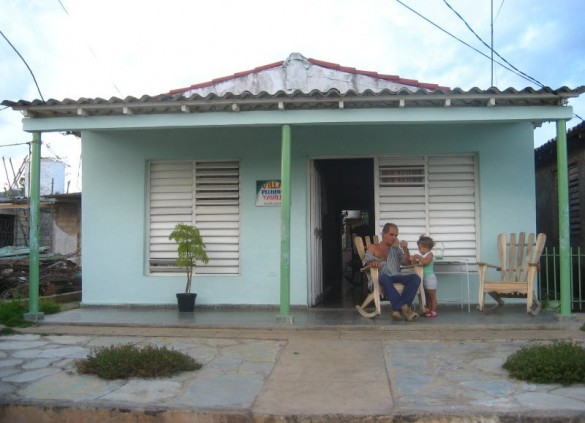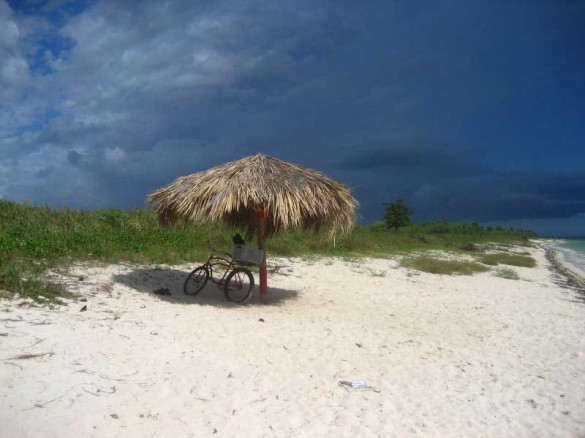‘Es verdad. Fue General’, Alfredo slurped noisily as he devoured the chicken leg. His eyes lit up suddenly as he put his chicken down, and he raised one hand, finger in the air, shaking it vigorously, standing as he did so.
‘Tengo una pistolera….!’
He walked into the adjacent room, evidently excited. Pistolera… wasn’t that…? I turned to see what he was doing as he went rummaging through a drawer.
I found myself staring down the barrel of a gun.
‘Bang bang….!’ He said with a wide grin on his face, before thumping me hard on the shoulder so as I nearly spat out my food.
He tossed the gun to one side casually, before sitting back down and went back to slurping at his chicken. The parrot trilled noisily in the background as if concurring. It was like being psyched out by some kind of bizarre double act. And then there was the Chihuahua. Would I crack…?
‘Mas ron?’ Alfredo proferred the bottle.
A ‘Casa Particular’ is accommodation whereby tourists or language students can stay with a local Cuban family, licensed by the government and usually inclusive of food, a bed and colourful company. Having decided to learn Spanish and having been recommended Cuba as an excellent travel destination; I’d decided to take some time off to marvel at Cuba’s wonderfully defiant politics and soak up some of its unique history and culture. Cigars, rum, salsa, Che Guevara, Ernest Hemingway and some of the best lobster I’d ever had were awaiting me.

It’d been nearly a week since Alfredo had opened his door to me, wearing nothing but a tight pair of shorts, his massive frame and fridge like belly accentuated by Max, the Chihuahua, yapping noisily at his ankles. My Spanish skills were ropey at best, but steadily improving, thanks to the daily sessions with Mercedes, a wonderfully eccentric and passionate professor, finely tuned to the political and economic situations of her country. ‘No hay’ is a familiar term associated with Cuba, literally meaning there isn’t any, and Mercedes had been quick to mourn the issues with her country; in particular the lack of commodities and most importantly the emigration of skilled professionals. Despite that, she had a look of immeasurable satisfaction on the day of our last lesson, when she posed our Spanish test question: ‘what were the causes of the global financial crisis and how could it have been prevented?’; suggesting that in at least one respect Cuba had something very much correct.
Courses and schemes such as this are available through simple web browsing or if feeling more adventurous just turning up at a Casa Particular in Cuba where your hosts will quickly find you a suitable teacher or means to improve your Spanish. In coming to Havana to improve your language skills, you’ll easily find plenty of ways to practice. Scooting around town in the wonderful egg shaped taxis, or in the stunning 1950s American cars there is plenty to talk about – Cubans’ love to discuss all sorts of topics; politics, history, Che Guevara and revolution all being high on the agenda. They are also gracious hosts, and will quickly recommend the best spots in town. Nothing makes a better evening than taking a Cuban taxi down to the Hotel Nacional after a long day of Spanish grammar; sipping a mojito in the garden whilst looking out onto Havana harbour and the city seawall. The wonderful art deco architecture of the building suggests that such distinguished guests as Churchill to Sinatra might only just have left yesterday – you could easily imagine Hemingway sitting outside, writing the final elements of his memoirs as he listened to some live musicians tapping on drums and strumming guitars.
The atmosphere and feel of Cuba and Havana cannot be described effectively without mentioning the music. From every street busker to every open microphone, the talent for music and dancing in Cuba is phenomenal. Take a simple walk down the streets of the Old Quarter to the Plaza de la Catedral and you will be met at almost every corner with some form of live band, dance or show; a vibrancy, colour and swagger that sets the streets alight. Everything has a beat, a rhythm, a step – the one, two, three; one, two, three of salsa making your feet itch to move.
A young Cuban guy told me of an evening, with an unnerving, intensity how: ‘salsa runs through the blood of every Cuban – a Cuban who cannot dance is like a bird who cannot fly’. Needless to say the sudden male panic of inadequacy, particularly at the laughable lack of rhythm I was displaying at my attempts at the simple one, two, three step of salsa had to be rectified through some basic lessons from Daniel and his friends. Salsa courses are common everywhere, and its easy to find a teacher – although be prepared to work hard at it as your lack of rhythm and inability to keep step will be quickly and brutally exposed by the effortlessness of the local dance partner you’re matched with. Still, a small price to pay when your skills on a night out suddenly opens up the floor to a vast selection of dance partners and a new form of interaction and sociability with the locals.

Such a night out in one of Cuba’s clubs is not without its dangers, however. The ‘mariposas’ (butterflies) is a polite term used to describe the young women who earn whatever they can through whatever means they can from visiting tourists. Usually distinguishable by the combination of paint stripper and burnt hair that somehow warrants an attractive perfume they will quickly be asking for drinks, demanding a dance and cosying up to you as intimately as possible. Travelling with an older companion is also an easy way to develop a complex; as a young guy there was definitely something disconcerting when my friend Derek, balding and well over fifty, was having women fling themselves at him left right and center while I wasn’t even getting a second look. The ultimate goal of a green card and a ticket to a better life is the dream for most of these girls and of course the motive for such preference; at least I repeatedly told myself. Derek wasn’t having any of it. It is however a small distraction, compared to socializing with most young Cubans whom on such a night out will simply be enjoying spending their time talking, drinking and dancing; happy to help you refine your salsa skills and find that elusive rhythm that’s been evading you since your arrival.
Once you’ve decided you need a break from dancing salsa incessantly and perfecting your Cuban colloquialisms with the locals, a few days out of the city are a must. The Piñar del Rio contains a unique and eye-catching landscape that is specific to Cuba and its countryside and simply unmissable. Viñales, the main stop in the region, is a beautiful city situated in the middle of lush vegetation and rolling hills and only a few hours by bus from Havana. This is also one of the main areas in which Cuba’s cigar production takes place, Cuba’s reputation for some of the best cigars in the world seeing Cuban Habanos and other leading brands forming its most lucrative and popular export. Demonstrations by the local ‘torcedores’ of the art form of cigar rolling are available for a few Cuban pesos; and along with a honeyed mojito and a horse back tour of the tobacco fields a perfect day can then be rounded out with a bottle of rum at Viñales Casa de la Musica in the main square of town.

If you prefer to sip your mojitos while staring out blissfully into the Caribbean ocean, then head to one of Cuba’s many famous beaches or seaside towns. Varadero is not far from Havana and has over 20km of white sand beaches; a tourist haven that developed as a result of the ‘tourism apartheid’ policies. Up until 1997 Cuban’s contact with foreigners was illegal, such contact considered to be for financial gain and thus stealing from the socialist state. This resulted, amongst other things, in parts of Cuba such as Varadero being developed primarily for foreigners use in order to help bring money into the ailing economy. These beaches are some of the most popular in Cuba, and if visiting you will be sharing with some of the half a million tourists who visit annually.
If you prefer something a little quieter head South to Trinidad, a stunning colonial town and a UNESCO world heritage site that has effortlessly preserved its colonial past through its cobblestone streets and multi-coloured walls, doors and windows. A short taxi ride from a stunning beach and home to restaurants and Casa Particulares serving some of the most stunning lobster in the country, it is an essential visit. The town is also local to the sugar cane fields of the Valley de los Ingenios, where the history of Cuba’s industry is evident through the various remnants of old sugar mills, all accessible by a 1906 steam train that departs daily.
Cuba is a unique and rewarding experience; a fascinating country brimming with all the energy and passion of its revolutionary history, productively channeled into music, dance and creative expression. As a venue to learn Spanish it provides an accessibility and sociability to its immensely enjoyable culture, and in Cuba such culture is varied, full and immersive; from the dance clubs of Havana to the sprawling hills of Piñar del Rio.
Nothing sums up Cuba better than the iconic image of Che Guevara in the Plaza de la Revolucion, symbolizing a country that despite its economic and financial hardships enjoys a pride of identity in standing separate from the corporate megaliths of consumerism; brimming with an infectious freedom of creativity and expression that from the first mojito to the final salsa step will leave you with warm memories and a satisfaction that will remain long after your trip is over.